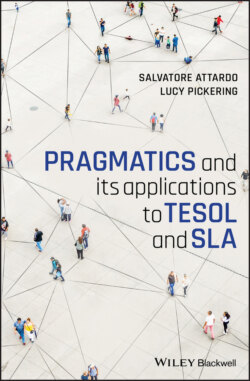Читать книгу Pragmatics and its Applications to TESOL and SLA - Salvatore Attardo - Страница 14
Intensional Semantics
ОглавлениеIntensional or structural semantics is concerned with the meaning of words and of sentences. Whereas referential semantics posits that the meaning of a word is its referent, intensional semantics is concerned with the sense of the expression. Sense is here defined as the relationship that a given word, for example, has in relation to the other words in the lexicon (the mental dictionary of speakers). So part of the meaning of “good” is that it is opposed to “bad” and related to “better” and “best” by a relation of scalar intensity (“better” is a higher degree of “good”). Another part of the meaning of “good” is that it describes an evaluation on the part of the speaker, relative to its object (so a good child is a child that behaves well, whereas a good donut is a donut that tastes good). Yet another part of the meaning of good is that it can occur as a modifier of nouns (“good boy”) but not of verbs (* I want to speak good). This part of the meaning is grammaticalized (part of grammar) as the fact that good is an adjective (part of speech) and not an adverb. The adverb of good is “well” and that too is part of knowing how to use “good” in English.
This does not exhaust the meaning of words. Lexical semanticists have figured out that word meanings are stored in the mental lexicon in the form of frames or scripts. Consider the following examples:
(1) a) John stacked the beer in the fridge.
b) ※ John stacked the water in the pool.
A moment of reflection shows that what makes (1.b) pragmatically odd is that pool water does not come in containers, let alone stackable ones. It is hard to imagine that “comes in stackable containers” is part of the lexical meaning of the word beer: most dictionaries define beer as an alcoholic beverage. Some provide the information that it is generally made from fermented cereals and flavored with hops. Few dictionaries provide the information that it comes in bottles, cans, or kegs. This information is considered non-lexical or encyclopedic (i.e., information about the world, not the lexical item). So the idea is that a frame or script contains all the semantic information about a given word: its lexical meaning, its connections with other words, the linguistic contexts in which it can occur (collocations), the extra-linguistic contexts in which it can occur, and of course any encyclopedic information available to the speaker. Frames and scripts are traditionally represented as a graph, a network of frames/scripts, with each link between two frames/scripts indicated by a labeled line connecting the two. Thus, for example, Figure 1.6 shows a small fragment of the semantic network around the word “chair.” “ISA” indicates that the relationship between the two terms is one of hyponymy, that is, a chair is a kind of furniture; “part_of” indicates that the term is a partonym (i.e., a part, a component of the item).
Figure 1.6 The semantic network of “chair.” “isa” labels hyponymy links.
Intensional semantics also accepts the principle of compositionality but expands on it with the idea of disambiguation. Consider the word “star.” “Star” has at least three meanings:
1 a celestial body, such as the sun, Alpha Centauri, and so on;
2 a prominent individual in a field, usually in entertainment, as in a movie star;
3 the symbol “*” in the ASCII keyboard (also known as “asterisk,” after the Greek “aster” = star).
The property of a word (or sign) of having more than one meaning is called ambiguity. Sentences can be ambiguous too. From the standpoint of communication, ambiguity is a problem: how do we know which meaning is the speaker conveying when he/she says: I found a star? Here the context in which the sentence is produced (to be discussed more fully later) comes to the rescue: suppose that the sentence I found a star is uttered by an astronomer, who is having lunch with a fellow astronomer at the observatory’s cafeteria, then the most likely sense is (1); if it is uttered by a movie producer having lunch with another producer, then the sense is probably (2); finally, if two proofreaders are talking about the progress of their work proofing a linguistic textbook, presumably the intended meaning is (3). The process of eliminating the unlikely meanings and narrowing down the interpretation of the utterance to the most likely in context is called “disambiguation.” An important point to stress is that disambiguation takes into account pragmatic/contextual factors. As we will see later, this is one of the reasons why drawing a boundary between semantics and pragmatics is so hard.
Disambiguation takes into account not only the context but also the co-text, that is, the rest of the text in which a given word occurs. So if Attardo asks for a cup of coffee, the presence of “cup” will select the meaning of “coffee” as a liquid, rather than as ground beans. Conversely, if Pickering asked for a pound of coffee, the presence of a weight unit for solids would disambiguate “coffee” to beans or ground beans.
